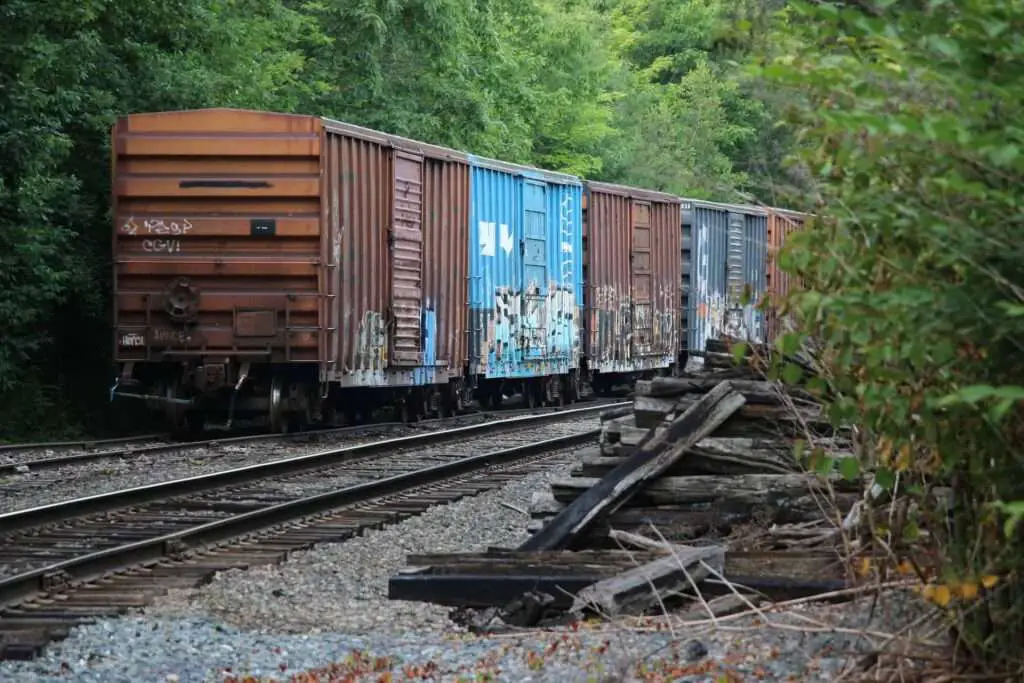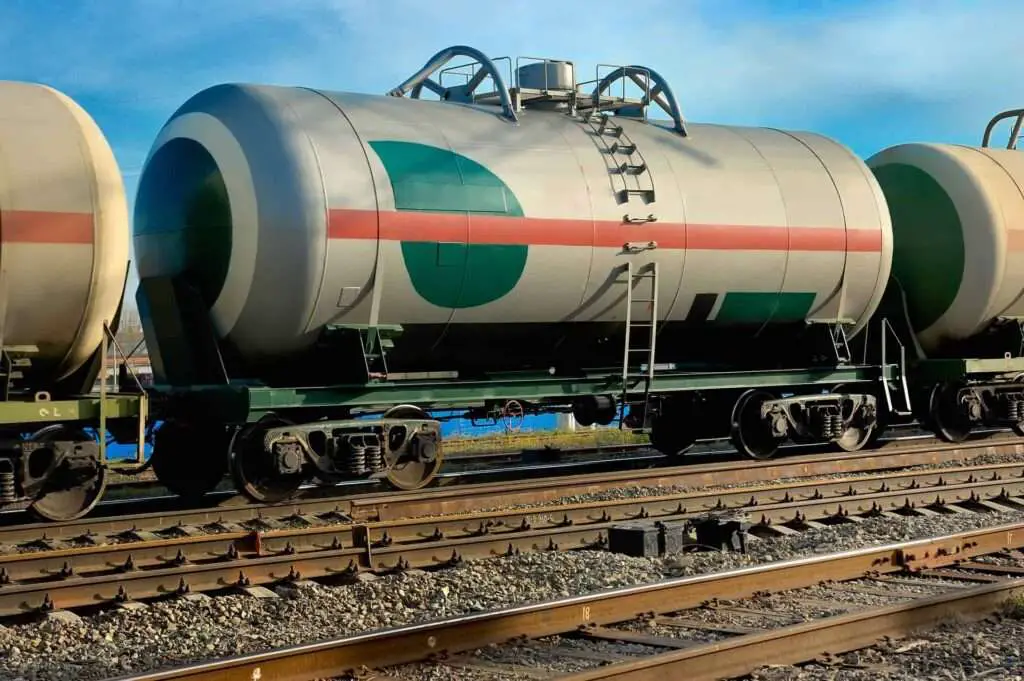
Freight trains are an essential part of the transportation industry. They carry large amounts of goods and commodities over long distances. They are an efficient and cost-effective way to move goods from one place to another.
Boxcars

Boxcars are the most common type of freight train and can be found transporting goods all over the world.
These cars are typically used to transport goods that don’t require a special type of car, such as coal, containers, grain, livestock, and other commodities.
Boxcars come in different sizes, and they can be outfitted with a variety of features to accommodate different types of freight.
They are equipped with sliding doors that allow easy loading and unloading of cargo, and some can also be used as tankers or flatbeds for carrying oversized items.
Some boxcars even have climate-controlled interior environments for carrying perishables like fruits, vegetables, and other foods that need refrigeration.
There are also auto carriers designed specifically for hauling automobiles and other vehicles.
Gondolas

Gondolas are some of the most commonly used freight trains for carrying bulk materials. They are typically open-top rail cars with shallow sides and ends.
Gondolas are often used to transport coal, ore, scrap metal, logs, and other heavy or large items. They can be up to 70 feet in length and hold up to 100 tons of cargo.
The weight of the cargo is often distributed evenly across the entire car so that the ride remains balanced.
Gondolas are known for their ability to handle difficult terrain, such as hilly terrain or rocky landscapes, without a problem.
The shallow sides of gondolas allow them to move around tight corners more easily than other types of freight trains.
Hoppers
Coal, gravel, and grain are commonly transported in hoppers, which are bulk freight cars.
These cars have an open top and bottom, with a sliding door that allows the material to be loaded and unloaded from the side or bottom. The open bottom allows for easy dumping of the materials at the destination.
Hoppers come in various sizes, depending on what they are used for and how much weight they need to carry.
They can range from a few thousand pounds all the way up to tens of thousands of pounds.
Hoppers are generally used for short-haul freight, since their open tops can make them vulnerable to the elements.
Tank Cars

Tank cars are used to transport liquids or liquefied gases, such as crude oil, diesel fuel, gasoline, and liquid fertilizers.
Tank cars are cylindrical in shape and are usually constructed from steel. They usually have insulation and are pressure tested to prevent leaks.
The walls of the tank car are also designed to reduce the amount of heat that is transferred between the inside and the outside.
Tank cars may also be equipped with safety features such as safety valves, pressure relief systems, and anti-rollover protection.
Tank cars can also be designed to contain hazardous materials, such as chlorine gas or corrosive acids, which require additional safety measures.
Tank cars are typically loaded and unloaded using special hoses or pumps, and the tank car must be able to withstand the pressure of these loading and unloading operations.
Loading and unloading times vary depending on the type of product being transported and the equipment used for the loading and unloading processes.
Reefers
Reefers are specialized freight cars designed to transport perishable goods, such as food and plants, that need to be kept at certain temperatures during transit.
These cars typically have a built-in refrigeration unit that is powered by the locomotive, either through an electric connection or through a belt from the locomotive engine.
Reefers are insulated to maintain the desired temperature, and their air vents are adjustable to allow for proper airflow.
These cars can also be pressurized to prevent bacteria growth and decay in foods that must be shipped over long distances.
Reefers are used in short- and long-haul freight trains and are most commonly seen carrying fruits, vegetables, dairy products, and seafood.
Flatcars
Flatcars are one of the most common types of freight trains and they’re designed to carry large, oversized items such as construction materials or heavy machinery.
Flatcars have no walls or sides, making it easier to load and unload items quickly and efficiently.
Some flatcars come with a crane that can help lift the items on and off the train.
They often have adjustable decks that can be lowered or raised depending on the size of the items being transported.
As a result, flatcars are the go-to choice for carrying larger, heavier items in bulk.
Intermodal
Intermodal freight trains are a hybrid form of freight transportation that combines different types of freight transportation, such as trucking, rail, and ship.
This is done in order to move cargo from one place to another in the most efficient and cost-effective way possible.
The containers used for this type of freight transport are typically made of metal and can be easily loaded and unloaded from multiple modes of transport without having to unpack them.
This makes them an ideal choice for transporting bulky items that require speed and efficiency.
Intermodal freight trains are often used for large-scale shipping, such as for the transportation of vehicles or oil.
They provide the benefit of being able to transport more goods with fewer trips, reducing both environmental impact and the cost associated with transport.
Specialty
Specialty freight trains are designed for the transport of non-standard cargo.
This type of train typically carries items such as oversized containers, large rolls of paper or cardboard, and some hazardous materials.
Specialty freight trains require special attention when it comes to loading and unloading these unique items, as well as ensuring that they are securely fastened.
The locomotive also requires a special design in order to accommodate these kinds of loads.
Due to their unique nature, these freight trains tend to be more expensive than standard types of freight trains.
Caboose
A caboose is a traditional rail car that was once found at the end of freight trains. It served as the home of the train crew, providing space to eat and sleep while on duty.
Modern cabooses are rarely seen on freight trains, as they have been largely replaced by devices known as “end-of-train” units.
This device is equipped with sensors that measure the temperature and brakes of the train and can also be used for remote communication.
Despite this development, cabooses still remain an important part of railroad history and can be seen in some parts of the country, especially on tourist railroads.
Do freight trains run everyday?
The answer to this question is largely dependent on the particular route and the specific freight train in question.
Generally, freight trains are operated by railroad companies who will have their own timetables and schedules. However, most freight trains run regularly throughout the week, with some even running seven days a week.
Freight trains also tend to operate more frequently during the peak periods of the day when there is more demand for transportation services.
How Are Freight Trains Scheduled? (Explained)
The frequency of the runs can also be affected by the weather, as well as other factors such as holidays or special events.
It is important to note that while freight trains run every day, there may be times when service is limited or suspended due to maintenance, delays, or other unexpected events.
Do freight trains carry passengers?
Freight trains are primarily designed for the transportation of goods, so they do not typically carry passengers.
Passenger services are usually handled by dedicated passenger trains, which can be operated by either public or private companies.
There may be exceptions to this rule depending on the region or country, but in general, freight trains are not designed or intended to carry passengers.
For example, some tourist lines or heritage railways may operate freight trains that occasionally carry passengers, but this is not their primary purpose.
Are freight trains fast or slow?
Freight trains can vary in speed depending on the type of cargo they are transporting, the type of terrain they are traversing, and other factors.
Generally speaking, freight trains are relatively slow when compared to passenger trains. This is because freight trains tend to be much heavier than passenger trains due to the amount of cargo they are carrying.
In addition, freight trains usually have to make frequent stops and they typically run on tracks that have slower speed limits.
That being said, certain types of freight trains, such as high-speed intermodal trains, can reach speeds of up to 79 mph (127 km/h).
These types of freight trains are designed to move containers quickly and efficiently between cities and can often transport cargo faster than trucking services.
However, most freight trains travel at speeds around 20 mph (32 km/h).
The speed of a freight train is also determined by the particular route it is taking.
For example, a train traveling on tracks that are built for higher speed limits may move more quickly than one traveling on a track with a lower speed limit.
In conclusion, freight trains typically move at slower speeds than passenger trains.
However, certain freight trains can reach higher speeds depending on their cargo, the type of terrain they are traversing, and other factors.
